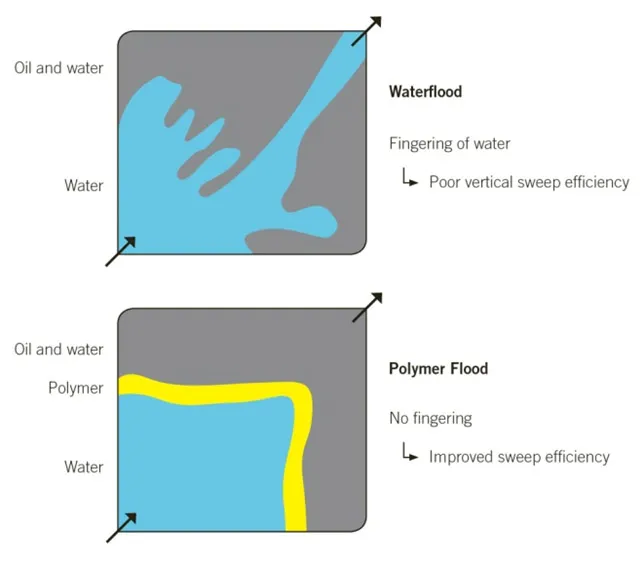Low shear polymer injection
Learn more about low shear: Technology Principles
Low Shear Polymer Injection
Introduction
Enhanced oil recovery (EOR) is a tertiary oil recovery method used to increase the amount of oil that can be extracted from a reservoir. Primary, pressure depletion, and secondary oil recovery, like water injection, only recovers 20 – 50 % of original oil in place (OOIP), so a large amount of oil is still trapped in the reservoir after conventional oil recovery processes. There are many different tertiary EOR methods, however, polymer injection and polymer flooding is the most important chemical EOR method used in sandstone reservoirs.
Polymer Injection
Inefficient oil recovery was recognized in the early 1900’s. Reservoir oil can be several orders more viscous than water. This makes it hard for the injected water to sweep trapped oil from the reservoir to the production wells. The consequence is breakthrough of the water stream to the production wells, which results in poor vertical sweep efficiency of the oil in the reservoir. In polymer flood operations, polymers like hydrolyzed polyacrylamides are used as mobility control agents to improve the macroscopic sweep efficiency of oil reservoirs. Polymers are long chain molecules composed of many repeated subunits with high molecular weight. By adding polymers, the injection stream gets more viscous than the oil. Alteration in the viscosity reduces breakthrough (fingering) of the water to the production wells, and hence increases the sweep efficiency of the oil the reservoir. Conventional water flooding with breakthrough of water is illustrated in Figure 1. In the lower figure, you can see the effect by adding polymer to the injection water. The improved sweep efficiency with polymers is also called the “piston effect” and can enhance oil recovery by 5 – 15 % compared to conventional methods.


Figure 2: Illustration of a polymer flood operation
Oil recovery from a reservoir is dependent on mobility ratio, and polymer injection improves the mobility ratio. Mobility is how permeable a porous media is to a given phase, divided by the viscosity of the phase. Mobility ratio is the mobility of the displacing phase divided by the mobility of the displaced phase. In polymer flooding, water-containing polymer is the displacing phase, and oil is the displaced phase, as can be seen in Equation 1.
According to Eq. 2 and Eq. 3 this would lead to lower energy dissipation rate, and bigger maximum droplet diameter respectively.

λ Mobility
μ Viscsosity
K Effective permeability
The benefits of polymer water flooding are:
- Improved sweep efficiency of the reservoir
- Accelerated production by reduced amount of injected water that must be co-produced to attain a given level of oil recovery
- Promoted incremental oil production by increased amount of oil produced before reaching the economic water-oil ratio production limit of a field.
Mechanical Degradation of Polymers
- The polymer dissolution facilities (static mixers and pumps)
- The injection lines: particularly the wellhead chokes
- The well bore entry
- Inject higher concentration polymer solutions
- Use more shear stable polymers
- Use injection pumps on each well line instead of injection valves
All of the above methods will increase the cost associated with the operation, and have a negative impact on OPEX. A fourth cost efficient option is to replace the existing injection equipment with low shear technologies.
Low Shear Polymer Injection Valve
Typhonix has since the start-up of the company (2006) focused on developing low shear fluid flow equipment, especially valves and pumps. As a result, the company has gained much expertise in particularly this field, and knowledge how to overcome these problems associated with mechanical shear in fluid flow devices. By reducing the pressure in a greater volume, or over a longer length, turbulence and shear forces are reduced.
In 2012, Typhonix started the development of a Low Shear Polymer Injection Valve. Since then, different locations where polymer degradation occur have been investigated, and new geometries and solutions have been implemented in a new polymer valve. The new valve keeps the strain rate under its critical value, which means that the polymer chain is not broken, and polymer degradation is minimized. Simultaneously, the new injection valve can maintain control of the fluid flow in terms of pressure and flow rate.
The valve is tailor-made for each customer, and is designed based on maximum allowable degradation, pressure drop and flow rate.
In 2018, a prototype was build and tested in a full-scale prototype test with diluted polymer solutions. A standard valve was tested in parallel, and the Low Shear Polymer Injection Valve reduced degradation with more than 80 % compared to the standard valve. In 2Q 2020, a pilot valve will be tested in a real field, where the application is on mother solutions. A commercially version of the valve will be available within the end 2020.
Downloads:
Low shear polymer injection
Learn more about low shear
In this section you will find some more information on different aspects of low shear. The main philosophy of low shear production is to instead of challenging the effects focus on the causes to separation problems.
Read more
